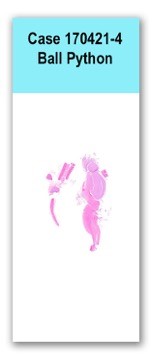Case 4 170421-4 (15K138)
Conference Coordinator: Wesley Siniard
//
Adult, male ball python (Python regius)
This is a ball python which was demonstrating severe neurologic signs approximately 3 months after being exposed to Golden Gate virus, a reptarenavirus that has been associated with inclusion body disease of boas. Red-tailed boas in the collection were clinically normal. However, biopsy samples from the red-tailed boas revealed large numbers of eosinophilic, intracytoplasmic, inclusion bodies and the tissues were PCR positive for Golden Gate virus.
No significant lesions.
This slide contains a sagittal section of brain and brainstem, as well as sections of spinal cord, nerve-root ganglia and nerve root. The samples of spinal cord are sectioned longitudinally and all are similarly affected by multifocal gliosis that is most evident in the grey matter. Necrotic neurons are scattered within the inflamed regions. A small number of granulocytes are scattered in the neural parenchyma and rarely blood vessels are cuffed by small numbers of lymphocytes. Endothelial cells of some blood vessels in affected regions are moderately hypertrophied. A moderate number of lymphocytes are scattered throughout the meninges and numerous lymphocytes, accompanied by small numbers of granulocytes, are aggregated in the neural parenchyma of the dorsal nerve root ganglia, adjacent to the meninges or vessels.
Lesions in the brain are similar to those of the spinal cord but are much milder. Small microglial nodules are scattered throughout the brain, most noticeably in the brainstem, particularly around brainstem nuclei. A few necrotic neurons are present in the brainstem foci. Lymphocytic infiltrates, granulocytic infiltrates, and endothelial hypertrophy are all present but are much milder than in the inflamed portions of the spinal cord. Very rare neurons contain ambiguous intracytoplasmic inclusions that are small and faint.
Immunohistochemistry using antibodies raised against Golden Gate virus, resulted in intense, specific staining of cells in regions of inflammation.
Spinal cord: Severe, acute, multifocal, meningomyelitis and ganglioneuritis with neuronal necrosis
Brain: Mild, acute, multifocal encephalitis
The clinical presentation of boas and pythons with this disease differs. Boas infected with this arenavirus can harbor it for years with few to no clinical signs. The course of the disease in pythons is more acute and neurologic symptoms are more profound. Most pythons die within days to weeks of clinical signs. Typical histologic findings include one- to four-micrometer-diameter, eosinophilic, intracytoplasmic, inclusion bodies in epithelial cells of multiple organs, with hepatocytes and renal tubular epithelial cells being most commonly affected. There are also typically intracytoplasmic inclusions in the brain and spinal cord associated with meningoencephalitis, neuronal degeneration, gliosis, and demyelinization.
Stenglein MD, Sanders C, Kistler AL, Ruby JG, Franco JY, Reavill DR, Dunker F, Derisi JL. 2012. Identification, characterization, and in vitro culture of highly divergent arenaviruses from boa constrictors and annulated tree boas: candidate etiological agents for snake inclusion body disease. mBio 3:e00180-112.
Chang L-W, Jacobson ER. 2010. Inclusion Body Disease, A Worldwide Infectious Disease of Boid Snakes: A Review. J Exot Pet Med 19:216–225.

